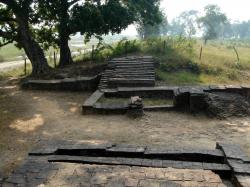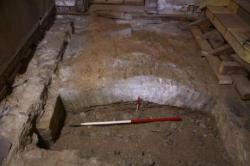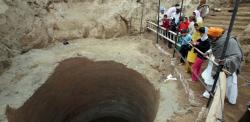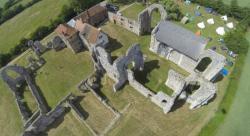INSTITUT SUPERIEUR D'ANTHROPOLOGIE
INSTITUTE OF ANTHROPOLOGY
ONLINE COURSES / COURS A DISTANCE
SPRING TERM : APRIL 2014
REGISTER NOW
ROYAUME UNI -  Plumpton- Fresh light has been shone on a Roman villa discovered deep in the East Sussex countryside. A geophysical survey to the north of Plumpton Agricultural College has provided dramatic clear images of the villa that lies below the fields between the South Downs and the Roman road along the Greensand Ridge. The existence of the villa has been known since the mid-1970s, when chalk and flint was brought to the surface by ploughing in the shape of the building, but these new images show the layout in much more detail and also prove the effectiveness of the college’s ‘set aside’ policy over the area of the remains. The resistivity survey was undertaken by volunteers under the supervision of local archaeologist David Millum, for the Sussex School of Archaeology, as part of a wider survey by Chris Butler Archaeological Services on behalf of Plumpton College. While the magnetic variation survey used over the larger area revealed several unknown features, the results were disappointing on the villa site but the electrical resistance survey, which shows the differences in moisture in the soil, picked out the remains clearly. The image appears to show a building of eight to nine rooms, around 40 metres wide facing south with protruding wings at each end. The more intense readings to the western wing may indicate a heated room or even a small bath suite.
Plumpton- Fresh light has been shone on a Roman villa discovered deep in the East Sussex countryside. A geophysical survey to the north of Plumpton Agricultural College has provided dramatic clear images of the villa that lies below the fields between the South Downs and the Roman road along the Greensand Ridge. The existence of the villa has been known since the mid-1970s, when chalk and flint was brought to the surface by ploughing in the shape of the building, but these new images show the layout in much more detail and also prove the effectiveness of the college’s ‘set aside’ policy over the area of the remains. The resistivity survey was undertaken by volunteers under the supervision of local archaeologist David Millum, for the Sussex School of Archaeology, as part of a wider survey by Chris Butler Archaeological Services on behalf of Plumpton College. While the magnetic variation survey used over the larger area revealed several unknown features, the results were disappointing on the villa site but the electrical resistance survey, which shows the differences in moisture in the soil, picked out the remains clearly. The image appears to show a building of eight to nine rooms, around 40 metres wide facing south with protruding wings at each end. The more intense readings to the western wing may indicate a heated room or even a small bath suite.
http://www.sussexexpress.co.uk/news/local/survey-reveals-dramatic-images-of-roman-villa-in-plumpton-1-5905940
NEPAL -  Tilaurakot- The second phase of excavations inTilaurakot that provided evidence substantiating the historical significance of the city concluded on Sunday.Addressing a programme organised to mark the conclusion of the excavation on Sunday, archaeologist Prof Robin Coningham, Vice-chancellor of the Durham University and co-director of the archaeological team, said the achievements made during the excavation were historic. He said the evidences found during the excavation shed light on the history of Tilaurakot . He said that the findings have validated the fact that the ancient city of Tilaurakot existed well before the birth of Prince Siddhartha who later became Buddha. The excavations, this year, were carried out at five locations. The team had found the remains of huge structures dating back to the Kushand era after digging a trench, 20 metres east of the western gates of the palace remains. The remains were found 10 to 30 centimetres below the surface. Likewise, the team found the walls of square-shaped pools one to two metres below the surface to the west of the palace remains. A team of Nepali archaeologists had found two small post holes (a cut feature used to hold a surface timber or stone) three metres under the ground last year. The recent excavations had led to the discovery of nine post holes 50 metres north-west to the security walls of the palace remains. As the discovery of post holes are dubbed as major achievements in an archaeological dig, Christopher Davis, chief archaeologist of Durham University, said that he was delighted by the finding of nine post holes ranging from 15 to 20cm diameter in size. The findings of the post holes had affirmed the historical significance of the city. The dig also revealed remains of a Vihar, 30mx30m in size while conducting a geo-physical survey near the Kanthak Stupa. Krishna Bahdur KC, an archaeological officer, said they had found remains of two Vihars. The statues of humans and animals, bangles made out of sand and an elephant replica made out of copper dating back to the Kushand era were found. The team also found stone chaplets, shields and the tip of an arrow belonging to the Lichhavi era, said Ram Kunwar, a senior archaeologist at the Department of Archaeology. More than 218,000, large and small, pieces of pottery having archaeological value were found. The work of taking photographs and drawing sketches of materials of archaeological significance were also completed. The excavation substantiated that Tilaurakot was a large and well-managed city before the birth of Lord Buddha, said senior archaeologist Kosh Prasad Acharya. Meanwhile, Prof Coningham said that the findings provide a hint at the possible connection of the ancient city to Taksha Shila located in northern Pakistan. As they found remains similar to that of Tilaurakot in Taksha Shila, Prof Coningham said that they would conduct studies to establish the possible connection between the two ancient cities. Taksha Shila, which was located in India before the partition, had a research centre about the teachings of Lord Buddha.
Tilaurakot- The second phase of excavations inTilaurakot that provided evidence substantiating the historical significance of the city concluded on Sunday.Addressing a programme organised to mark the conclusion of the excavation on Sunday, archaeologist Prof Robin Coningham, Vice-chancellor of the Durham University and co-director of the archaeological team, said the achievements made during the excavation were historic. He said the evidences found during the excavation shed light on the history of Tilaurakot . He said that the findings have validated the fact that the ancient city of Tilaurakot existed well before the birth of Prince Siddhartha who later became Buddha. The excavations, this year, were carried out at five locations. The team had found the remains of huge structures dating back to the Kushand era after digging a trench, 20 metres east of the western gates of the palace remains. The remains were found 10 to 30 centimetres below the surface. Likewise, the team found the walls of square-shaped pools one to two metres below the surface to the west of the palace remains. A team of Nepali archaeologists had found two small post holes (a cut feature used to hold a surface timber or stone) three metres under the ground last year. The recent excavations had led to the discovery of nine post holes 50 metres north-west to the security walls of the palace remains. As the discovery of post holes are dubbed as major achievements in an archaeological dig, Christopher Davis, chief archaeologist of Durham University, said that he was delighted by the finding of nine post holes ranging from 15 to 20cm diameter in size. The findings of the post holes had affirmed the historical significance of the city. The dig also revealed remains of a Vihar, 30mx30m in size while conducting a geo-physical survey near the Kanthak Stupa. Krishna Bahdur KC, an archaeological officer, said they had found remains of two Vihars. The statues of humans and animals, bangles made out of sand and an elephant replica made out of copper dating back to the Kushand era were found. The team also found stone chaplets, shields and the tip of an arrow belonging to the Lichhavi era, said Ram Kunwar, a senior archaeologist at the Department of Archaeology. More than 218,000, large and small, pieces of pottery having archaeological value were found. The work of taking photographs and drawing sketches of materials of archaeological significance were also completed. The excavation substantiated that Tilaurakot was a large and well-managed city before the birth of Lord Buddha, said senior archaeologist Kosh Prasad Acharya. Meanwhile, Prof Coningham said that the findings provide a hint at the possible connection of the ancient city to Taksha Shila located in northern Pakistan. As they found remains similar to that of Tilaurakot in Taksha Shila, Prof Coningham said that they would conduct studies to establish the possible connection between the two ancient cities. Taksha Shila, which was located in India before the partition, had a research centre about the teachings of Lord Buddha.
http://www.ekantipur.com/2014/03/03/national/tilaurakot-excavation-concludes/386143.html
ROYAUME UNI –  Cardigan -Archaeologists say the discovery of a medieval archway buried in the floor of Castle Green House is the most exciting find yet at Cardigan Castle.The archway looks as though it links to the medieval cellar beneath the house. It is one of the few remains of Lord Rhys's 12th century stone castle that hosted the first eisteddfod back in 1176. Archaeologist Nigel Page said: "There are so few elements left of the medieval castle that this really is an exciting discovery. It all adds to the story of the site." He added that it was likely the archway was the original entrance to the north tower.Mr Page added that the walls of the house followed the lines of the original medieval castle as Georgian builders took advantage of the stonework for foundations.;;The original stone castle was badly damaged during the Civil War with the site being filled in to create a town bowling green in the 18th century.
Cardigan -Archaeologists say the discovery of a medieval archway buried in the floor of Castle Green House is the most exciting find yet at Cardigan Castle.The archway looks as though it links to the medieval cellar beneath the house. It is one of the few remains of Lord Rhys's 12th century stone castle that hosted the first eisteddfod back in 1176. Archaeologist Nigel Page said: "There are so few elements left of the medieval castle that this really is an exciting discovery. It all adds to the story of the site." He added that it was likely the archway was the original entrance to the north tower.Mr Page added that the walls of the house followed the lines of the original medieval castle as Georgian builders took advantage of the stonework for foundations.;;The original stone castle was badly damaged during the Civil War with the site being filled in to create a town bowling green in the 18th century.
http://www.tivysideadvertiser.co.uk/news/11048798.Hidden_medieval_archway_uncovered_at_Cardigan_Castle/?ref=var_0
INDE –  Ajnala -Archaeologists will examine claims that remains of people exhumed from an abandoned well in Punjab belong to soldiers who revolted against British rule in 1857, officials said yesterday. The remains of 282 soldiers executed by the British were found inside the premises of a Sikh temple in Ajnala town, local official Surinder Singh said over phone. “There are references in historical texts to these freedom fighters who had sacrificed their lives during the mutiny, known as India’s first war of independence in 1857,” Singh said. “But this is yet to be confirmed. Experts from the archaeology department will soon begin a probe and possibly carry out carbon-dating on the remains,” he said. Besides 80 human skulls, skeletons and spent bullets, coins and medals that date back to the Victorian era were also found from the excavated well, said shrine chief Amarjit Singh Sarkaria. Historian Surinder Kochhar, who initiated the excavation, says the troops were from the 26th Bengal Native Infantry stationed at Lahore who escaped after killing two British officers, hearing of reports of mutiny in other parts of India. The soldiers were captured in Ajnala where they were thrown into a well that was later covered with soil, he said. The digging of the well started on Friday, preceded by Sikh, Hindu and Muslim prayers. Scores of volunteers were involved in digging the well, which was earlier called “kalian wala khu” (well of the blacks). It is now referred to as the “shaheedan wala khu” (well of the martyrs). Be it members of the gurdwara committee, NGO activists, men and women from the town or even school children - all were involved in the digging and excavation work. “These were our freedom fighters who sacrificed their lives during the First War of Independence. The British pushed them into the well here and let them die,” said Amarjit Singh Sarkaria, president of Gurdwara Shaheed Ganj. The gurdwara came up at the site as a tribute to the martyrs. “We will perform their last rites with the respect and honour they deserve,” Sarkaria said. Kochhar said it was an emotional moment for the people of Ajnala town when the skulls and bones were taken out. Residents and gurdwara committee members, however, rued that the government never bothered about the martyrs for 157 years. The gurdwara committee and others engaged in excavation said a suitable memorial and a museum would be built at the site to honour those who laid down their lives for the country. The rebellion of 1857 was sparked when Indian soldiers of the British East India Company - Hindus and Muslims - refused to use bullet cartridges said to be greased by beef and pork fat.
Ajnala -Archaeologists will examine claims that remains of people exhumed from an abandoned well in Punjab belong to soldiers who revolted against British rule in 1857, officials said yesterday. The remains of 282 soldiers executed by the British were found inside the premises of a Sikh temple in Ajnala town, local official Surinder Singh said over phone. “There are references in historical texts to these freedom fighters who had sacrificed their lives during the mutiny, known as India’s first war of independence in 1857,” Singh said. “But this is yet to be confirmed. Experts from the archaeology department will soon begin a probe and possibly carry out carbon-dating on the remains,” he said. Besides 80 human skulls, skeletons and spent bullets, coins and medals that date back to the Victorian era were also found from the excavated well, said shrine chief Amarjit Singh Sarkaria. Historian Surinder Kochhar, who initiated the excavation, says the troops were from the 26th Bengal Native Infantry stationed at Lahore who escaped after killing two British officers, hearing of reports of mutiny in other parts of India. The soldiers were captured in Ajnala where they were thrown into a well that was later covered with soil, he said. The digging of the well started on Friday, preceded by Sikh, Hindu and Muslim prayers. Scores of volunteers were involved in digging the well, which was earlier called “kalian wala khu” (well of the blacks). It is now referred to as the “shaheedan wala khu” (well of the martyrs). Be it members of the gurdwara committee, NGO activists, men and women from the town or even school children - all were involved in the digging and excavation work. “These were our freedom fighters who sacrificed their lives during the First War of Independence. The British pushed them into the well here and let them die,” said Amarjit Singh Sarkaria, president of Gurdwara Shaheed Ganj. The gurdwara came up at the site as a tribute to the martyrs. “We will perform their last rites with the respect and honour they deserve,” Sarkaria said. Kochhar said it was an emotional moment for the people of Ajnala town when the skulls and bones were taken out. Residents and gurdwara committee members, however, rued that the government never bothered about the martyrs for 157 years. The gurdwara committee and others engaged in excavation said a suitable memorial and a museum would be built at the site to honour those who laid down their lives for the country. The rebellion of 1857 was sparked when Indian soldiers of the British East India Company - Hindus and Muslims - refused to use bullet cartridges said to be greased by beef and pork fat.
http://www.gulf-times.com/india/185/details/383263/archaeologists-to-examine-remains-of-282-martyrs
G-B -  Leiston Abbey - Situated less than 15 miles from the famous Anglo Saxon-era Sutton Hoo site, Leiston Abbey was virtually untouched and unexcavated during the 800 years since it was founded in the 1300s, until last year when site custodians Pro Corda teamed up with DigVentures to run a community excavation, seeking to understand the unique history of the site.
Leiston Abbey - Situated less than 15 miles from the famous Anglo Saxon-era Sutton Hoo site, Leiston Abbey was virtually untouched and unexcavated during the 800 years since it was founded in the 1300s, until last year when site custodians Pro Corda teamed up with DigVentures to run a community excavation, seeking to understand the unique history of the site.
http://www.heritagedaily.com/2014/03/excavations-to-continue-at-suffolks-leiston-abbey/102348